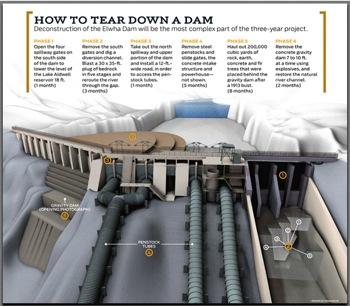Almost 100 years ago, the Elwha River which flows through the heart of Olympic National Park was dammed up to produce some power for the nearby town of Port Angeles, Washington. Power for the city is now produced elsewhere (most likely from dams located on the Columbia River), and the two Olympic Peninsula dams, Elwha and Glines Canyon, have outlasted their necessity. In fact, they are now quite a nuisance to salmon restoration efforts. The fish, once able to migrate 100 miles inland have been stopped at the dams, only 5 miles from the coast.
Getting rid of the dams hasn't been easy. It's not that there are a lot of people protesting this move, it's just that the process has been painfully slow. Groups including the NPCA, the Lower Elwha Klallam Tribe, and the National Park have been working at this since 1992. If everything goes as planned, the dams could be dismantled starting in 2009.
The Tacoma, Washington paper covered this issue in a recent article - "A river regained; Project to bring back salmon, bear, eagles".
Right now, 5,000 to 10,000 salmon return to the river. But the fish have just the lower five miles in which to spawn before reaching the Elwha Dam. Officials said 22 species of wildlife, including bald eagles, black bears and river otters, have declined because of a lack of salmon carcasses in the upper river.
Removing the dams will give fish access to more than 70 miles of habitat.
The goal, Elofson [the river restoration director for the Lower Elwha Klallam Tribe] said, is to produce runs that reach 400,000 fish.
"I think it’s doable," he said. "Eighty-seven percent of the drainage is in the park, so that habitat is protected."
The state will concentrate on restoring chinook runs, while the tribe concentrates on coho, chum, pink salmon and steelhead. Fish eggs, fry and yearlings will be planted upstream to build new runs.
Restoring runs to such levels will take time, likely between 12 and 30 years, Elofson said.
"I’m hoping it will happen as fast as the Toutle (River) rebounded after Mount St. Helens erupted," he said. "I’d just love it if it took just a couple of runs."
I love the quote they picked to finish off the article from Elofson describing the long, long river restoration process, "I wouldn’t want to tell my kids we had the chance to restore this river and we didn’t take it."




Add comment